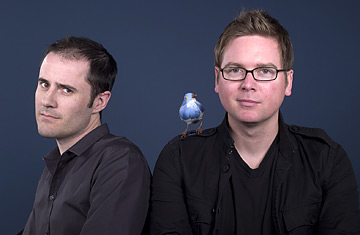
Evan Williams and Biz Stone of Twitter
(7 of 8)
The speed with which users have extended Twitter's platform points to a larger truth about modern innovation. When we talk about innovation and global competitiveness, we tend to fall back on the easy metric of patents and Ph.D.s. It turns out the U.S. share of both has been in steady decline since peaking in the early '70s. (In 1970, more than 50% of the world's graduate degrees in science and engineering were issued by U.S. universities.) Since the mid-'80s, a long progression of doomsayers have warned that our declining market share in the patents-and-Ph.D.s business augurs dark times for American innovation. The specific threats have changed. It was the Japanese who would destroy us in the '80s; now it's China and India.
But what actually happened to American innovation during that period? We came up with America Online, Netscape, Amazon, Google, Blogger, Wikipedia, Craigslist, TiVo, Netflix, eBay, the iPod and iPhone, Xbox, Facebook and Twitter itself. Sure, we didn't build the Prius or the Wii, but if you measure global innovation in terms of actual lifestyle-changing hit products and not just grad students, the U.S. has been lapping the field for the past 20 years.
How could the forecasts have been so wrong? The answer is that we've been tracking only part of the innovation story. If I go to grad school and invent a better mousetrap, I've created value, which I can protect with a patent and capitalize on by selling my invention to consumers. But if someone else figures out a way to use my mousetrap to replace his much more expensive washing machine, he's created value as well. We tend to put the emphasis on the first kind of value creation because there are a small number of inventors who earn giant paydays from their mousetraps and thus become celebrities. But there are hundreds of millions of consumers and small businesses that find value in these innovations by figuring out new ways to put them to use.
There are several varieties of this kind of innovation, and they go by different technical names. MIT professor Eric von Hippel calls one "end-user innovation," in which consumers actively modify a product to adapt it to their needs. In its short life, Twitter has been a hothouse of end-user innovation: the hashtag; searching; its 11,000 third-party applications; all those creative new uses of Twitter--some of them banal, some of them spam and some of them sublime. Think about the community invention of the @ reply. It took a service that was essentially a series of isolated microbroadcasts, each individual tweet an island, and turned Twitter into a truly conversational medium. All of these adoptions create new kinds of value in the wider economy, and none of them actually originated at Twitter HQ. You don't need patents or Ph.D.s to build on this kind of platform.
